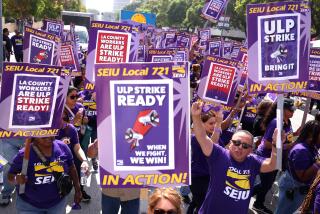Wave of Strikes Signals Return of Long-Quiet Labor Unions
- Share via
A rejuvenated labor movement showed its muscle in a six-month wave of strikes and street protests, the likes of which had not been seen in Los Angeles for at least a generation.
From low-wage immigrant janitors to bus drivers at the edge of the middle class, strikers clogged thoroughfares and disrupted public services as they clamored for a “fair share” of the prosperous economy.
Results were mixed: Office janitors, who kicked off the surge of activism in April, won an unprecedented 25% raise over three years to end their three-week strike. The master contract also made it easier for the union to expand into nonunion Orange County.
Bus drivers for the Metropolitan Transportation Authority, who paralyzed the city’s transit system for a month in the fall, fought off some proposed contract changes that would have greatly expanded a tier of lower-paid, part-time drivers.
The union representing about 47,000 county workers, which vowed to shut down public services unless demands for significant raises were met, called off the strike after a day of tepid support from the membership. Leaders later signed a contract that provided an average raise of 12%, splitting the difference between its demand and the county’s original offer.
Union actors ended a six-month walkout against the ad industry in October after winning large increases in fees for commercials that appear on cable television. But the Screen Actors Guild failed to win its demand for residual payments for cable ads. Also disappointed were about 72,000 home care workers, who won a 50-cent hourly raise after a series of marches and sit-ins.
More to Read
Sign up for Essential California
The most important California stories and recommendations in your inbox every morning.
You may occasionally receive promotional content from the Los Angeles Times.








